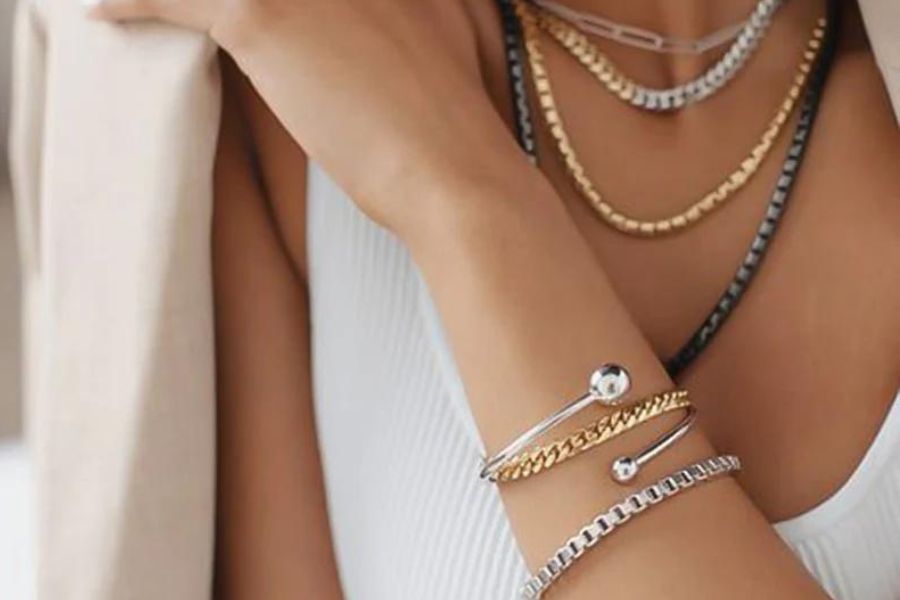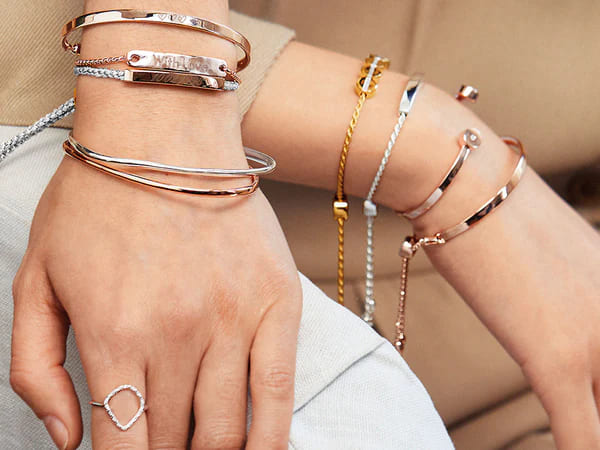Jewellery trends are evolving, and one of the most exciting trends is mixing metals. Gone are the days when fashion rules dictated wearing only one metal at a time. Today, gold, silver, and rose gold can be combined to create chic, versatile looks that suit both casual and formal occasions.
In this guide, we’ll explore practical tips on mixing metals, how to pair different pieces, and ways to make your jewellery work seamlessly with your wardrobe.
Why Mixing Metals Works
The rise of mixed-metal styling is rooted in versatility. Wearing different metals together can:
- Add depth and dimension to your look
- Make outfits more interesting without being overpowering
- Allow you to incorporate inherited or sentimental pieces without worrying about matching
For example, a rose gold necklace can perfectly complement a silver watch and gold rings, creating a cohesive yet dynamic ensemble.

Understanding Each Metal
Before mixing metals, it’s important to understand their unique qualities and how they interact with skin tones and outfits.
Gold
Gold is a classic, timeless choice that works well with almost every style. Yellow gold tends to suit warmer skin tones, while white gold is more neutral. It’s often the dominant metal in jewellery collections, making it a good anchor for mixed-metal looks.
Silver
Silver offers a sleek, modern aesthetic. Its cooler tone contrasts beautifully with gold, providing balance. Silver pieces are versatile and can be worn with both casual and formal attire.
Rose Gold
Rose gold has a warm, romantic hue. It’s perfect for adding subtle color and elegance. Its pinkish tone blends well with both gold and silver, making it a natural bridge between the two.
Tips for Mixing Metals Successfully
Mixing metals can be intimidating, but following some key guidelines ensures a polished look.
Start with a Base Metal
Choose one metal to act as your base. This helps unify your look and prevents it from appearing chaotic. For example, if you’re wearing mostly gold, add hints of silver or rose gold through rings, bracelets, or small necklaces.
Use Layering to Your Advantage
Layering necklaces or stacking bracelets is a popular way to mix metals. Combine different lengths and textures to create interest while keeping your outfit harmonious.
Match with Outfit Colors
Consider your clothing colors when mixing metals. Neutral tones like white, black, or beige allow your jewellery to stand out, while bold colors can be complemented with warm gold or rose gold accents.
Mix Metals in Odd Numbers
Odd numbers create a more visually appealing arrangement. Wearing three rings in different metals, for example, looks intentional and stylish compared to an even-numbered combination.
Pairing Metals with Stones
Gemstones can further enhance your mixed-metal look. Diamonds, pearls, and colored stones like sapphires or emeralds can help bridge gold, silver, and rose gold pieces.
For instance:
- A silver bracelet with diamonds can harmonize with a rose gold ring
- Gold settings around colored gemstones can complement silver chains
Using stones as connectors creates a cohesive aesthetic without making the metals clash.
Mixing Metals for Different Occasions
Different settings call for different approaches to mixing metals.
Everyday Wear
For casual outfits, opt for subtle metal mixing. Pair silver hoops with a rose gold watch or layer a few mixed-metal bangles. Keeping pieces minimal ensures the look stays effortless.
Office and Professional Settings
In professional environments, you can mix metals tastefully by choosing refined pieces like a gold chain with silver studs or a rose gold bracelet with a silver watch. Avoid overly flashy combinations to maintain a polished, sophisticated appearance.
Special Events
For weddings, parties, or formal events, feel free to experiment more boldly. Stack multiple rings in gold, silver, and rose gold or layer necklaces in different lengths and textures. Combining metals can elevate your ensemble, making it luxurious and fashion-forward.
Common Mistakes to Avoid
While mixing metals is versatile, there are pitfalls to watch out for:
- Overcrowding: Too many pieces can make your look feel chaotic. Aim for balance.
- Ignoring Skin Tone: Certain metals complement specific skin tones better. Test combinations before committing.
- Clashing Styles: Mixing modern and vintage pieces without cohesion can create a mismatched effect. Try to maintain a consistent aesthetic.
Iconic Ways to Mix Metals
Here are a few tried-and-true combinations to inspire your style:
- Silver and Rose Gold: Use silver as the base with subtle rose gold accents for warmth
- Gold and Silver: Anchor with gold pieces and sprinkle silver rings or bracelets for contrast
- Tri-Metal Layering: Combine all three metals through necklaces or stackable rings for a bold statement
The key is confidence—wearing mixed metals with ease often looks more intentional than overthinking the combinations.
Caring for Mixed-Metal Jewellery
When wearing mixed metals, care is crucial to keep your pieces looking their best:
- Store metals separately to prevent scratching
- Clean each metal with its recommended method
- Avoid exposure to harsh chemicals that can tarnish silver or dull rose gold
Proper care ensures your mixed-metal pieces remain beautiful and wearable for years.
Read Also : How to Mix and Match Jewellery for a Stylish Look
Final Thoughts
Mixing metals like gold, silver, and rose gold is no longer a fashion risk—it’s a creative way to showcase personal style. By understanding each metal’s characteristics, following simple styling rules, and paying attention to your outfit and accessories, you can create polished and sophisticated looks for any occasion.
Whether you’re layering necklaces, stacking rings, or pairing bracelets, the key is balance and confidence. Embrace the versatility of mixed metals and elevate your jewellery game.
By experimenting with combinations and considering your personal aesthetic, you’ll discover that gold, silver, and rose gold can coexist beautifully, transforming everyday jewellery into statement pieces that reflect your unique style.

